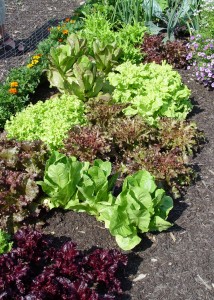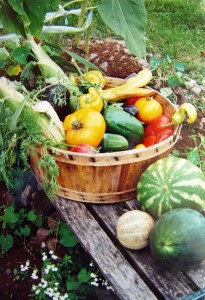Flooded Vegetables
September 13th, 2011
I hate to tell you, but if your fruits, vegetables and herbs got submerged in last week’s flooding, most of it is probably too risky to eat.
Even if it just got splashed by flood water, some of it could still be contaminated.
A few things factor into this – especially what might’ve been in the water, how susceptible different crops are to contamination and how long your edibles were in contact with the dirty water.
In theory, you should be able to give everything a good scrubbing and eat away.
In reality, though, pollutants get trapped in the nooks and crannies of the plant parts and even get absorbed into the flesh of skinned fruits.
Cooking or disinfecting kills bacterial pollutants, but the problem is that’s not all that’s in flood water.
“Chlorine will kill bacteria, but there may be other compounds in the water like diesel fuel and solvents,” says Dave Swartz, director of the Cumberland and Perry County Extension offices. “Chlorine is not going to help that.”
Neither will cooking.
Swartz’s advice: Discard anything that got flooded or splashed.
In other words, when in doubt, throw it out.
Not everyone even agrees that soaking edibles in chlorine is a good idea in the first place.
Some experts say if you dilute it properly and wash it off food before eating, chlorine treatment is effective and far less of a risk than eating bacteria-contaminated produce.
Others say chlorine is not effective enough to risk eating something that most likely is contaminated.
Your choice. If you use chlorine to disinfect produce, here are some dilution guidelines from Cornell University: for 6 percent chlorine bleach, use one-half of a teaspoon per quart; for 4 percent chlorine bleach, use 1 teaspoon per quart, and for 2 percent chlorine bleach, use three-quarters of a tablespoon per quart. Immerse for 15 to 20 minutes and then rinse thoroughly with safe-to-drink water.

Lettuce is among the riskiest crop to try and salvage after a flood. Those ruffled and layered leaves are tough to clean.
The riskiest crops to try and salvage after a flood are ones eaten raw that also have nooks, crannies and layers that are difficult to clean.
These include leafy crops such as lettuce, chard, spinach, collards, kale, parsley, mustard and basil; veggies such as celery, broccoli, cabbage and leeks, and soft fruits such as strawberries, raspberries, currants and blackberries.
Slightly less risky are crops with fleshy fruits and thin skins, such as tomatoes, peppers, zucchini, other summer squash, beans and tree fruits (apples, peaches, pears). Hopefully, the water didn’t get high enough to soak your apples.
Those crops pose more of a risk because they’re more likely to absorb pollutants. So even if you cook them to kill bacteria, you can’t be sure what kind of absorbed solvents or chemicals are still active in the flesh.
In general, the longer these crops were in contact with the water, the more they had a chance to absorb pollutants.
A step more salvageable are fruiting crops that have husks or thick protective skins – things like corn, eggplant, melons and shell peas.
If you can peel away sections of the plant that came into contact with flood water and absorbed most of any pollutants, odds of are decent that the inside edible parts are OK. Cooking well is still a good idea.
The least risky crops are ones that you normally wash, peel and cook, such as carrots, potatoes, red beets and onions.
After you’re out working in your flooded garden, be sure to wash well immediately. Let your dirty clothes and shoes outside so you don’t bring any contaminants into the house. And make sure your tetanus shot is up to date. My doctor says gardeners should get a tetanus booster every 5 years instead of every 10 years for “regular” people.
Also don’t dig in wet soil. You’ll compact the air pores and ruin its texture and future drainability.
Raised beds may have bailed some people out in cases where flooding got close. But when we get that much rain, there’s really nothing you can do other than think about moving the garden to a higher, drier area if this happens to you often enough.
The good news is that soil is such a great filter, even a totally flooded-out garden will be safe to replant next spring.
Combining the effects of sunlight, fresh rain and soil microbes, most pathogens are dead meat in 90 days. Even uncomposted manure in gardens is accepted as being deactivated of bacterial threat in 4 to 6 months.
Whether the soil will produce as well next year or not is an open question.
On one hand, soggy soil can become compacted and can lose beneficial microorganisms that break down nutrients and supply nutrition to plants in a form their roots can use. Drowning earthworms isn’t good either.
On the other hand, some of that deposited silt may bring along nutrients and organic matter that actually improve what you started with.
In other words, maybe there’s a silver lining in here somewhere…
Weekend Events
I’ll be at Lurgan Greenhouse and Nursery this Saturday doing a talk on “Gardening for All Four Seasons.” It’s a program that’ll help you make your landscape look good and change throughout the year, including winter. It’s free and starts at 10 a.m. Come on out.
The folks at Lurgan ask that if you’re planning to go, give them a call ahead of time at 709-8064 so they’ll have enough space set up. If you’ve never been there, this is a full-service garden center in a beautiful setting at 8126 Oakdale Road, Orrstown, about 10 or 15 minutes north of Shippensburg.
Also worth checking out this weekend is the BEE Local festival at the Fredricksen Library, 100 N. 19th St., Camp Hill. On Saturday from 1 to 5 p.m., all sorts of booths, vendors and talks related to bees and local food will take place. It’s also free. And on Friday evening at 7 p.m., the library will offer a free showing of a new film on the global bee crisis and what it means to us.








